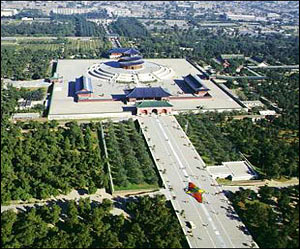
In the face of increasing pressure from restricted resources, the Chinese capital plans to slow down its population growth in order to make the city more life friendly, according to a newly revised city plan for 2004-20, the beginnings of which were released on Saturday.
The long-term plan, a fundamental document to guide development over the next 16 years, says the city will try to keep its population within 18 million until 2020.
This means the city's annual population growth rate would need to be lowered to 1.4 percent from the current 2.5 percent. So far, there are about 14.5 million people living in Beijing, 3 million of whom are migrant workers.
Experts have long appealed for the city's population to be kept in line with the capacity of its resources. Its annual water availability per capita is less than 300 cubic meters, about one-32nd of international levels. Some have estimated that the city's water resources could only bear 17 to 18 million people at the very most.
Beijing has undergone rapid expansion far exceeding expectations over the past decade.
According to the previous plan made in 1993, the city predicted 14 million residents by 2040. However, this target figure was reached last year - 37 years earlier than expected. And the number of vehicles in the city exceeded 2.2 million by June this year, far higher than the 1.3 million that had been set for 2010.
As a result, the city had to revise city plans early this year, and included the concept of "building a society suitable for living" for the first time. Besides aiming to slow down population growth, the revised plan stresses the role of satellite towns to alleviate pressure on central areas.
The city will build 11 new towns on its outskirts, of which three - Tongzhou, Shunyi and Yizhuang in eastern Beijing - will be key locations to which a large portion of population and industries will move.
The multi-center layout will be an improvement on the current arrangement of concentric circles with one center, blamed as the root cause for endless traffic jams in Beijing. The downtown area, covering only 12 percent of the city, now sees nearly a quarter of its traffic flow because over 400 government organs and institutions are crowded into it.
Moving more population and industries out of the central urban area where many ancient buildings stand, the old city's functions will shift towards cultural entertainment and sightseeing.
The revised layout pays greater attention to the protection of the old city, which was the capital of five dynasties, from the Liao Dynasty (916-1125) to the Qing Dynasty (1644-1911).
According to the layout, the city will stop massive demolition and construction in the downtown area, and make more efforts to rehabilitate its historical face.
Public transit construction is another key point of the new plan. The plan intends for over half those traveling to choose public transit by 2020, much higher than the 27 percent in 2000.
The newly revised plans are on display at the Beijing Plan Museum, located on Qianmen East Street, where there will be free public access until Friday. The entire city plan will be unveiled after getting approval from the State Council.
(China Daily, china.org.cn November 8, 2004)
|

